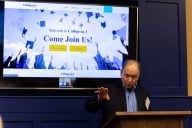You have /5 articles left.
Sign up for a free account or log in.
In every generation since 1862, America has innovated on the form of the university. Until ours.
From the land-grant universities to Clark Kerr’s seminal work, America’s higher education landscape has faced almost continuous “innovator’s dilemma.” Competition in its purest sense reigned as new forms of institutions continuously forced America’s universities to be the best in the world or be overtaken by upstarts.
America’s higher education institutions have a history of embracing change because the ecosystem is very different from other industries. While each new institutional form was extremely controversial in its time, new providers in higher education tend to expand access (or the definition of what higher education is) rather than replace existing institutions.
For example, community colleges became feeders to four-year schools while research universities brought a research agenda to almost every university. It’s the equivalent of cars complementing rather than replacing the horse-drawn carriage or AltaVista retaining its market after the rise of Google.
This period of stagnation in higher education innovation is tied to an anniversary we just celebrated -- the 50thyear of the Higher Education Act. The Higher Education Act began the Title IV financial aid program that provided government-guaranteed loans and Pell Grants to students at colleges that follow the strict, input-based metrics of success effectively required by the Higher Education Act.
The impact is clear. Only colleges willing to follow the government’s strict guidelines could access “free” government money. Without new entrants, prices for college rose inexorably for the last 50 years and, especially in the last decade, policy makers, parents and students started asking serious questions about the efficacy of the university system.
The Department of Education is finally offering the catalyst for our generation of education innovators to continue the tradition of new institutional forms. The source of hope is the awkwardly named Education Quality Through Innovative Partnerships (or EQUIP). At its heart is a refreshing challenge to innovators: How would you reimagine the university of the future without the strictures imposed by the Higher Education Act and Title IV? If you didn’t have regulations driving an antiquated system of input-driven variables, what postsecondary experience would you design?
There are many concerns about the EQUIP program. As with any new program, the first participants and how they are overseen will define the success of EQUIP. The Department of Education, accreditors and university partners face a compelling challenge: ensuring that the programs approved are high quality.
There appear to be two mechanisms. First, the department is limiting the initial program in scope and number. Second, the department and quality-assurance bodies must closely scrutinize the new models to ensure the academic integrity of the higher education ecosystem and protect government funds and students from undue risk. History will decide if these guardrails are sufficient.
The department is not taking the risk to launch EQUIP in a vacuum. New entrants have emerged that fill specific massive workforce demands or highly disruptive models. MOOCs with tens of millions of viewers are reaching a whole generation of potential college goers. Galvanize and General Assembly will train more technology workers than traditional universities will grant computer science degrees by 2017. Udacity is selling nanodegrees tied to employment in high-demand areas.
These new providers have all realized a fundamental disconnect: while 96 percent of provosts feel they are preparing students for work, only 11 percent of business leaders think colleges are effectively preparing graduates for work. Into this gap, students have been willing to pay out of pocket -- without federal financial aid -- for these services.
In effect, students are willing to pay out of pocket tens of thousands of dollars more for coding schools than traditional computer science classes by forgoing federal government subsidies. The results are clear: the average student who starts at Galvanize has an average salary of $45,435; after a six-month immersive experience, the average graduate makes approximately $76,821.
While the MOOCs and boot camps are front-page news, other new models are emerging -- for example, experiential providers like UnCollege creating gap year opportunities. Universities are not left out of the new models -- in fact, some of the most promising examples of new models involve partnerships between traditional universities and Silicon Valley like the Minerva Project.
The boot camps, MOOCs and nontraditional providers are only the start of what will likely be one of the greatest periods of revolution in higher education. A thank-you to the Department of Education for recognizing this trend and creating EQUIP.
The entrepreneurial spirit of American higher education innovators has been stifled for too long and is now ready to bloom.
A Bit of History
Below is a brief list of the types of revolutions/evolutions of the higher education form over the past generation. While historians of higher education may differ on certain trends, the overall scope of change and innovation in higher education is clear.
|
Key Year |
Driver |
Sample Universities Formed |
|
State University System, 1862 |
Railroads and the Civil War made clear that industrialization of economy was coming. New technology drivers of old industries (e.g., farming) portended massive shift from rural economy to urban. |
Michigan State University, University of Maryland |
|
Research University, 1880s |
American industrialists saw the need for combining teaching and research into one institution, and made large philanthropic gifts to create the modern research university. |
Johns Hopkins University, Stanford |
|
Community Colleges, 1920s/1930s |
“New economy” workers realized that a BA degree was not required for numerous jobs and skills in the 20th century. |
Pima Community College, LaGuardia Community College |
|
California Plan, 1960s |
Mission creep among the public university systems required a new rule book for higher education systems. |
University of California System |
|
EQUIP, 2015 |
Technology portends change in teaching methodologies and rise of new disciplines (like coding). |
To be determined
|








